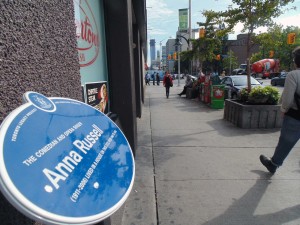Toronto Heritage recognizes HVRA Storyposts

This Toronto Legacy Plaque on Bloor Street honours Anna Russell, the “funniest woman on the opera stage”, says Grace Westcott, chair of the Toronto Legacy Project. The group has been nominated for a 2015 Heritage Toronto Award, one of several Annex-related nominees this year. Brian Burchell, Gleaner News
By Annemarie Brissenden
How do we define a city’s heritage? Is it the network of buildings connected by meandering streets and avenues? Is it a shared history of accepted truths?
If this year’s nominees for the Toronto Heritage Awards are anything to go by, our heritage is as woven out of the conflicting narratives, shared memories, and individual triumphs of our collective past as it is from our built history.
“We are getting people to think of heritage as a much broader concept than buildings,” explains Dr. Nicole Schulman, the producer of the Harbord Village History Storyposts, a project of the Harbord Village Residents’ Association that has been nominated in the media category.
Located throughout Harbord Village, there are 24 Storyposts: bright yellow outdoor plaques with QR codes that, when scanned by a smartphone, guide listeners to an audio collage created from interviews with long-time residents, organized by theme. Some are light-hearted, recounting memories of the games children played, while others cover more serious subjects like racism and anti-Semitism.
Very much inspired by murmur, a documentary oral history project that records stories about specific locations, the Storyposts took about two and a half years to produce, and grew out of a companion project to capture the oral stories of the neighbourhood’s oldest residents before those stories were lost.
For Schulman, who notes that at times the individual voices contradict each other, the “oral testimonies convey the reality that there is not a single truth” and remind us that “we do have history, and it helps shape who we are today”.
One of the biggest challenges was figuring out where to locate the plaques: the one about chestnut trees, for example, is placed so a listener is looking at a chestnut tree, while the one about the games children played is placed in front of a park.
Choosing “which site does the most justice to the individual” is not always easy, allows Grace Westcott, chair of the Toronto Legacy Project, which oversees the Toronto Legacy Plaques in partnership with Heritage Toronto. “Sometimes you choose visibility over historical significance.”
Nominated in the community heritage category, the project has erected 37 distinctive blue plaques that mark where a person of note once lived or accomplished something significant.
There is a large cluster of plaques in the Annex honouring notables such as Lester B. Pearson (Admiral Road), Norman Bethune (Robert Street), and champion rower Ned Hanlon (Beverley Street). And, it’s hard not to miss Anna Russell’s plaque amid the hustle and bustle of Bloor Street just west of Spadina Avenue.
Westcott’s favourite plaque, however, is the one honouring Jane Jacobs on Albany Avenue.
Part of the Annex cluster, it’s located where Jacobs lived when she was fighting the Spadina expressway, between two trees that she planted, in an area that still exists as a result of her work.
“It’s redolent of Jane Jacobs and everything she stood for.”
Modelled on the blue plaques of London, England, which date to 1866, the program was founded in 2009 by Toronto’s then poet laureate Dennis Lee — of Alligator Pie fame — who wanted to bring greater prominence to the city’s great achievers. (Have you heard, for example, of Donald Coxeter, the most important mathematician since Euclid? There’s a plaque for him.)
For Westcott, the Heritage Toronto nomination is a recognition that “we’ve accomplished something… something that’s noticed and has value”.
“Encouraging recognition of the city’s heritage in all its forms” helps to remind us to preserve that heritage, says Kevin Plummer, the Heritage Toronto board member who chairs the Awards Working Group.
One of the buildings up for recognition in the architecture category is the one Uno Prii designed at 100 Spadina Rd.
Unlike the fate suffered at Prii’s 44 Walmer Rd., where the original distinctive balconies were removed and never replaced, the exterior appearance of 100 Spadina Rd. was restored.
“Uno Prii’s buildings were a cohesive whole, and the balconies were part of his original vision,” relates Plummer. “It certainly strikes a contrast to [44 Walmer Rd.] in terms of how the owner of 100 Spadina Rd. is trying to maintain the heritage of the building.”
There are two other local landmarks nominated in the architecture category, the sanctuary at Trinity-St. Paul’s United Church, which underwent significant upgrades to its accessibility, stage size, and acoustics, and the Munk School of Global Affairs, whose interior masonry, original windows, and interior staircase were restored.
For further information about the Harbord Village History Storyposts, or to hear them in their entirety, please visit http://www.HarbordVillageHistory.ca. For further information about the Toronto Heritage Awards, or to buy tickets, please visit www.heritagetoronto.org.
